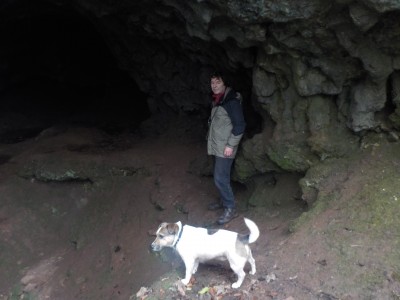 31st January 2016: Walking with Roz and Buster. Stormy weather so we decided to go where there was more shelter to be found and a walk around Rowberrow woods. There are forestry operations being carried out at the moment so a bit mucky underfoot in places. There is something about freshly felled and cut wood on the hillside, reminds me of being in the Alps where the sound of timber being cut echoed across the valleys and the aroma of cut pine was in the air. Not very many people about today which was also good. Some large swathes of trees have cleared opening up areas of the wood, unfortunately this has had the effect of exposing more trees to the strong winds and there are a lot of wind blown trees lying on the ground. I suppose these will eventually be cleared away. The shelter the trees give from the wind is noticeable as you pass from cleared hillside to were the trees are untouched – yet.
31st January 2016: Walking with Roz and Buster. Stormy weather so we decided to go where there was more shelter to be found and a walk around Rowberrow woods. There are forestry operations being carried out at the moment so a bit mucky underfoot in places. There is something about freshly felled and cut wood on the hillside, reminds me of being in the Alps where the sound of timber being cut echoed across the valleys and the aroma of cut pine was in the air. Not very many people about today which was also good. Some large swathes of trees have cleared opening up areas of the wood, unfortunately this has had the effect of exposing more trees to the strong winds and there are a lot of wind blown trees lying on the ground. I suppose these will eventually be cleared away. The shelter the trees give from the wind is noticeable as you pass from cleared hillside to were the trees are untouched – yet.
No walk around this area is complete without a visit to Rowberrow Cavern.

Rowberrow
Cavern, located at ST 4596 5802.
The cavern comprises a large archway in
Dolomitic Conglomerate that rapidly closes down with a side passage on the left. Archaeological
excavation by UBSS between 1921 and 1926 revealed Neolithic, Bronze Age, early
Iron Age and Romano-British habitation. The excavations have left their mark on the surrounding area where the large spoil heap although overgrown is still noticeable and a deep trench leads to the entrance chamber.
Human use of the cave spans a long period although probably not continuously so. The
Upper Palaeolithic appears to be represented by a few flint implements and possibly
some animal remains; the discovery of microliths and a core suggest some Mesolithic activity.
The Neolithic/Early Bronze Age was represented by a range of flint implements
including knives, as well as some Beaker potsherds. Iron Age finds included
pottery, a light blue bead, and traces of iron smelting. Romano-British finds
included potsherds, a number of coins (some possibly “British
imitations”, i.e. counterfeit), and a few pieces of copper alloy and of
lead. Some bone objects are suggested by Branigan and Dearne to be Iron Age,
while some human skeletal fragments are suggested to be pre-Roman. Some of the faunal assemblage may have been contemporary with the Iron Age and
Roman use of the cave (Simmonds, V.J. Overview of the archaeology of Mendip caves and karst. www.mendipgeoarch.net).

 31st January 2016: Walking with Roz and Buster. Stormy weather so we decided to go where there was more shelter to be found and a walk around Rowberrow woods. There are forestry operations being carried out at the moment so a bit mucky underfoot in places. There is something about freshly felled and cut wood on the hillside, reminds me of being in the Alps where the sound of timber being cut echoed across the valleys and the aroma of cut pine was in the air. Not very many people about today which was also good. Some large swathes of trees have cleared opening up areas of the wood, unfortunately this has had the effect of exposing more trees to the strong winds and there are a lot of wind blown trees lying on the ground. I suppose these will eventually be cleared away. The shelter the trees give from the wind is noticeable as you pass from cleared hillside to were the trees are untouched – yet.
31st January 2016: Walking with Roz and Buster. Stormy weather so we decided to go where there was more shelter to be found and a walk around Rowberrow woods. There are forestry operations being carried out at the moment so a bit mucky underfoot in places. There is something about freshly felled and cut wood on the hillside, reminds me of being in the Alps where the sound of timber being cut echoed across the valleys and the aroma of cut pine was in the air. Not very many people about today which was also good. Some large swathes of trees have cleared opening up areas of the wood, unfortunately this has had the effect of exposing more trees to the strong winds and there are a lot of wind blown trees lying on the ground. I suppose these will eventually be cleared away. The shelter the trees give from the wind is noticeable as you pass from cleared hillside to were the trees are untouched – yet.
